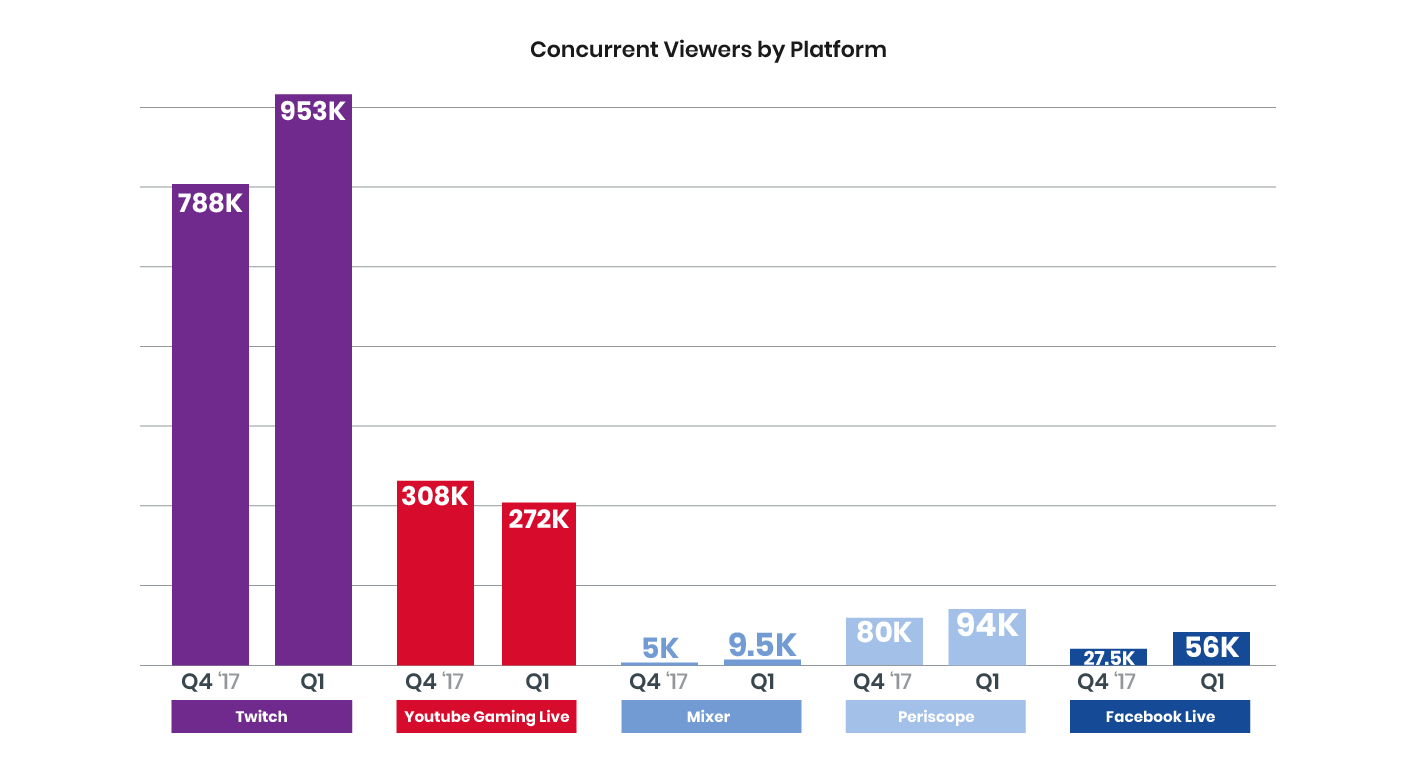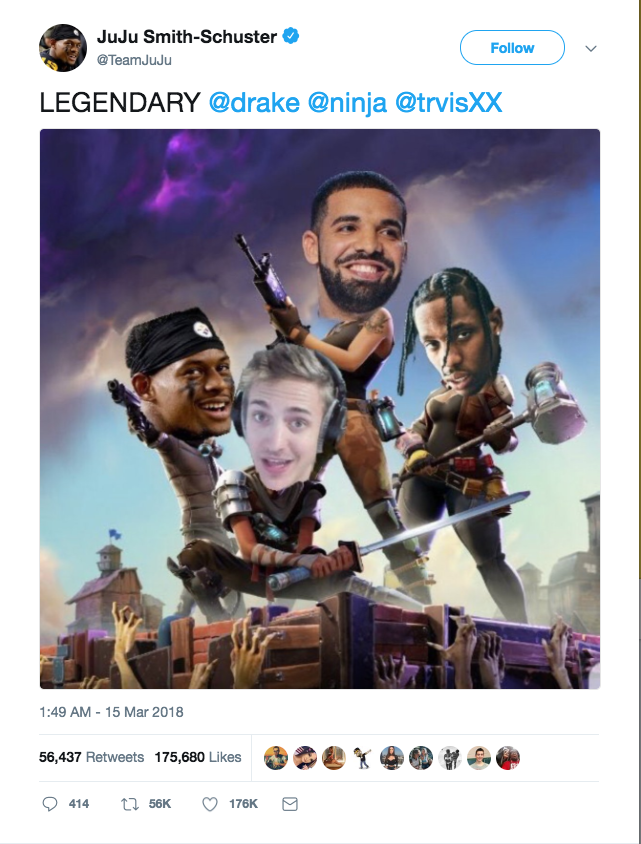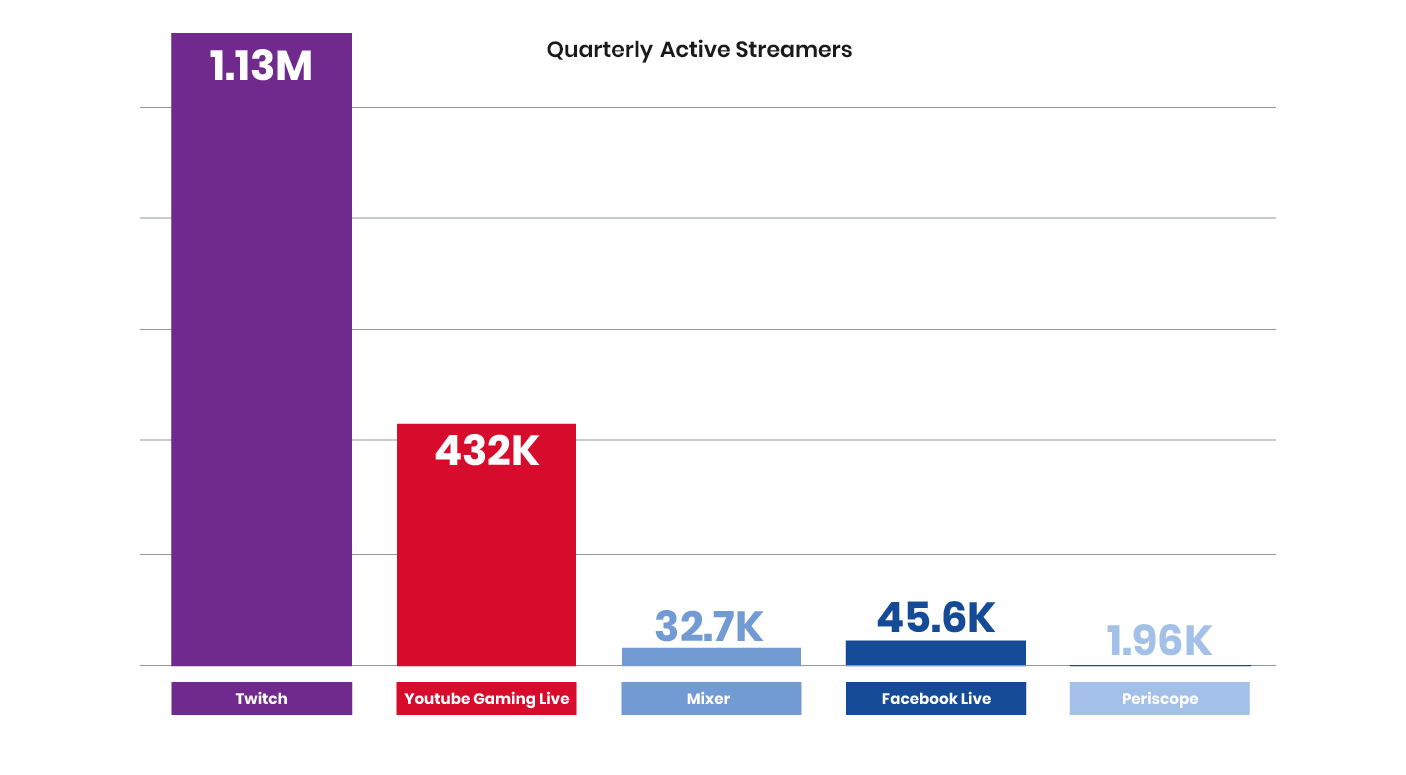
➤➤ Highlights for Q1'18, TL;DR
Streamlabs paid out over $34 million in tips in Q1 2018; up 33% from Q4’s $26 million
Big viewership growth on Twitch — concurrent viewers up 21% in one quarter, while viewership on Youtube Gaming declined
Fortnite had over 8.3 million hours streamed becoming the #1 streamed game on Twitch, surpassing both PUBG and League of Legends
Streamlabs Desktop (new streaming software) went into open beta in January, and is now responsible for 15% of all streams on Twitch
Where were you when Fortnite’s largest player, Ninja, and hiphop megastar Drake got together to stream Fortnite on Twitch? The duo broke the previous record of 388,000 viewers for a single-player stream and hit 628,000 concurrent viewers at its peak on March 14, 2018. Live streaming continues to grow in popularity and is becoming more common, as personalities from sports, music, as well as as popular creators on YouTube are flocking to Twitch and other live streaming platforms. In our first quarterly report this year, you will see that the popular platform Twitch, has taken a considerable lead over the competition, and is solidifying itself as the leader in the space.
According to a report prepared by Newzoo, Twitch and YouTube Gaming has generated 2.5 billion hours of watch time in 2018. Majority of this growth came from Twitch, as YouTube decreased 12% while Twitch grew 21% relative to Q4 2017.
It should come as no surprise that Fortnite is now the most streamed game on Twitch and this quarter had a whopping 8.3 million hours streamed, with over 1.3 million unique streamers playing the game.
In case you missed it, in January Streamlabs introduced a new streaming software, Streamlabs Desktop, which launched in open beta. Streamers are really enjoying it, and it is already responsible for more than 15% of all livestreams on Twitch.
#1. Streamlabs Desktop — 15% of all Twitch streams

Streamlabs Desktop is an all-in-one desktop application for video streaming. It comes with >100 free custom overlays to personalize your stream, enables you to save up to 25% of your CPU, and takes <60 seconds to set up.
.The new broadcasting software Streamlabs Desktop that was released in open beta in January now accounts for 15% of all Twitch streams. This is now the second-largest broadcasting software in the market, behind standard OBS. This is measured by dividing the number of channels live with Streamlabs Desktop by the total number of channels live on Twitch at any given point, in 1- minute intervals, averaged over the course of a day.

Streamlabs’ mobile broadcasting apps (Android & iOS) are now the most-popular IRL mobile broadcasting apps, due in part to built-in alerts, widgets and tipping. It’s like having the power of your desktop application on your phone.
Together Streamlabs Desktop and the Streamlabs Mobile apps are generating 18% of all video ingest into Twitch today.
#2. Tipping to broadcaster up 33% to $34.7 million
In Q1 we saw our largest quarterly increase ever in Streamlabs tipping volume : up 33% to $34.7 million, from $26.2 million the previous quarter. Streamlabs has now paid out a total of $260 million to streamers in total, over the course of three years.


Ranging from 27% to 38%, the number of monetized channels are also on the rise. More and more streamers are starting to earn an income, making live streaming a more viable as a career.
We believe part of the increase in tipping volume is driven by a number of factors. Some of the factors are (1) streamers setting progressively higher production quality bar, (2) new hit games such as Fortnite attracting mass audiences, (3) growth in demand for non-gaming genres, (4) ever-increasing stream of sponsors and advertisers and much more.
#3. Twitch rises 21%; Facebook & Mixer 2X in Viewers

Twitch (21%), Facebook (103%), Periscope (18%) and Mixer (90%) grew significantly in terms of the most important metric — viewers. Youtube Gaming’s viewership declined. Twitch also added more concurrent viewers — 165K — than the rest of the industry combined. The large percentage growth from Facebook and Mixer suggests that both platforms added new featurs, invested in marketing and content deals, solving key product challenges, and hitting a rich vein of growth. Facebook’s new game streaming center, for example, now looks a lot more like Twitch.
Please note that this data does not track Mixer’s viewership on Xbox (which is most of their viewership), and does not track private streams on Facebook only to your friends.
Back in February Twitch confirmed that the record number of concurrent viewers for an individual stream was set at over 388,000 by Dr. Disrespect, and then in March we saw that record smashed by Ninja with his stream with Drake and Travis Scott hit 628,000. So it should come as no surprise that the leading platform saw growth in this area.

Note that Twitch also had an increase in concurrent streamers by 33%

Streamers tend to be a leading indicator of the health of a platform, and we saw the largest increases in Twitch (33%), Mixer (282%) and Periscope (126%). Youtube Gaming declined in concurrent streamers, in-line with trends we saw in viewership data.
#4. Streamers using Streamlabs up 39% Quarterly
Total monthly active streamers using Streamlabs across all platforms rose in Q1 by 39% compared to Q4' 2017 across all platforms. Twitch continues to see a healthy growth in active users. The popular streaming platform had over 1 million quarterly active streamers in Q1, rising 31% from Q4.
The Spanish YouTuber ElrubiusOMG also recently broke the record held by Ninja (Tyler Blevins) and at one time managed to bring in 1.1 million concurrent viewers on YouTube.
Streamers may begin to flock to YouTube Gaming to take advantage of the viewers that are looking for more Fortnite streamers, with less competition from those over at Twitch.

Here is a monthly breakdown of all the platforms, by unique streamer. If a streamer is active all three months, the streamer is counted is once. However, if they are not, the streamer is only counted for the one instance they streamed that month for that time they did stream (in that month). That streamer is however counted for the quarter. You will notice that Mixer witnessed a 50% increase in streamers, while Facebook only saw a slight decrease by 15% compared to Q4' 2017.
Microsoft’s streaming platform Mixer now includes native streaming support from Xbox, Windows PCs, mobile phones, as well as innovative viewer-interaction features. These features coupled with large exclusive partnership with Hi-Rez (studio behind Smite) likely contributed to strong growth for Mixer.
Streamers using Streamlabs on Periscope increased by 173% from Q4' 2017. This was the first full quarter where Periscope was fully supported by Streamlabs.

#5. Fortnite Dominates Game Streaming

As mentioned earlier in the report, both Twitch and YouTube saw streamers breaking viewer records this quarter. So, it’s quite easy to see how Fortnite, Epic Games’ Battle Royale holds the #1 spot as most streamed game this quarter. Just to show its dominance, back in Q4 PUBG was the leader at having 4 Million hours streamed. In Q1 alone, Fortnite has more than doubled that number, clocking in more than 8 Million hours. In Q4' 2017, Fortnite was bringing in 2.7Million hours. This is an increase of over 5Million hours in only 4 months.

We expect Fortnite to continue its dominance of gaming and live streaming in the next quarter.
As the Battle Royale genre heats up it and more games enter the space, it is interesting to think about who will be the most popular game in this genre in 9–12 months and why.
In 2018 alone, we’ve seen several polished titles enter the Battle Royale space. Among them Island of Nyne, Radical Heights, Darwin Project. Each game attempts to differentiate itself either via polish, a radical aesthetic, or a new way to engage the audience.
There is one AAA gaming studio that is missing from the scene. Blizzard. Will Blizzard enter the scene with an adapted version of Overwatch or a brand new game with a new engine and new lore?
Thanks for reading, we hope you find this data interesting and helpful. Feedback? We’d love to hear it.
